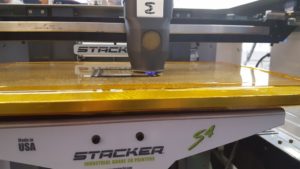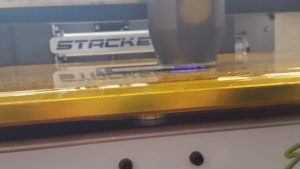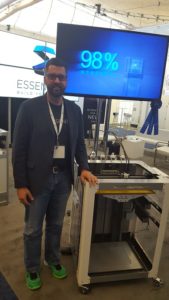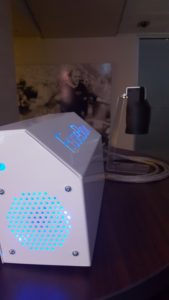 When it comes to FFF-based 3D printing methods, new machines may come out on a fairly regular basis — many of which work with unique materials incorporating everything from wood to carbon fiber to concrete and stepping away from conventional materials like PLA — but not a lot has fundamentally changed since the first machines debuted their extruding capabilities in the early 1980s. Materials development and innovations in nozzles have enhanced capabilities in some truly impressive manners, making layer-by-layer manufacturing relevant to an ever-widening buffet of possibilities, there’s no denying that. But the physics behind such has remained a fairly well-understood process. Essentium Materials wants to change that.
When it comes to FFF-based 3D printing methods, new machines may come out on a fairly regular basis — many of which work with unique materials incorporating everything from wood to carbon fiber to concrete and stepping away from conventional materials like PLA — but not a lot has fundamentally changed since the first machines debuted their extruding capabilities in the early 1980s. Materials development and innovations in nozzles have enhanced capabilities in some truly impressive manners, making layer-by-layer manufacturing relevant to an ever-widening buffet of possibilities, there’s no denying that. But the physics behind such has remained a fairly well-understood process. Essentium Materials wants to change that.
Essentium’s President and CTO, Blake Teipel, PhD, told the gathered crowd at the company’s launch party, held in the Champions Club at Heinz Field (home of the Pittsburgh Steelers) following the RAPID + TCT welcome event, that the FlashFuse journey has been a long one. The company moved away from microwaves and into plasma, which Teipel and the Essentium team see as breathing new life into additive manufacturing, specifically into FFF — which, Teipel said, “is alive and well with FlashFuse technology.”
“We coat fabric with carbon nanotubes, then heat that; layers weld together and reach 98% of the strength of injection molded parts, with no post-processing,” he said during the announcement. “This is a new level of strength. It’s a game changer for an industry depending on practical parts.”
 I think we can all agree at this point that “game changer” doesn’t necessarily mean anything anymore when said in a press release/press conference setting, so I sat down with Teipel after the announcement to lift that jargon veil. The company has spent the last two years working on changing the physics of 3D printers, he told me. In a 30-year old technology, over time this idea had been explored, to bond between each layer to produce stronger parts, but had proven a catching point holding back the potential for FFF 3D printing.
I think we can all agree at this point that “game changer” doesn’t necessarily mean anything anymore when said in a press release/press conference setting, so I sat down with Teipel after the announcement to lift that jargon veil. The company has spent the last two years working on changing the physics of 3D printers, he told me. In a 30-year old technology, over time this idea had been explored, to bond between each layer to produce stronger parts, but had proven a catching point holding back the potential for FFF 3D printing.
“This changes the whole equation, for the first time in 30 years,” he explained. “We’re creating parts that rival isotropic tolerances of injection molded parts. This is scalable, from FDM on the desktop up to BAAM; any size will work for our technology. It’s cost-effective, as we keep all expensive materials as a thin-film coating on the outside. This keeps costs down, to a point. The operating principle is a multi-layer filament hit with high-energy plasma: that’s our secret sauce. It couples in multi-layer filament, it’s not conducting electricity to the build plate, it’s heating volumetrically; that’s what makes this so exciting.”
He added, “This can matter in structural prosthetics, for example, as parts made this way are strong enough to last as long as carbon fiber fabric. It capitalizes on the innate advantages of 3D printing.”
Along with Essentium at the launch party were partners BASF, AON3D, and STACKER 3D, all of which Teipel thanked and noted are launching wide-ranging industrial support. I sat down next with Kevin Han, Co-Founder and CEO of AON3D, to learn more about that partnership. For a company that has told us before that it sees materials as being key to the future of 3D printing, AON3D seems well set to move forward with FlashFuse technology.
“We’ve been working with Essentium for a while now. since November or so. The partnership originally covered materials and then we started talking more, learned more, FlashFuse came up in the conversation — and it was a great fit. We get stronger parts, which really benefit the end user. We can see industrial use targeting here for high-performance materials in conjunction with the technology, that’s the best use of it,” Han told me.
“We’re excited about the launch and working as a beta customer. There are just additional things you can do with plasma and polymer chemistries; we’re really excited about what’s going to happen.”
The launch party had a FuseBox system on display, but not in action; this was saved for the exhibit hall floor, where I caught up again with the Essentium, AON3D, and STACKER 3D teams to see the plasma at work. Check out some 3D printing with plasma technology on a STACKER 3D printer (the STACKER S4 with the FuseBox system runs about $16K):
Alden Warr from the Essentium team pointed to the working system and reiterated that it can be applied to any FFF-based 3D printer. Plasma, he explained, is the pathway to go through and heat materials and create fusion, working with PLA, PEEK, polyamides, and more. He noted of the partnership with global chemical giant BASF that, “We’re their foot into FDM,” as the company has largely been focusing on industrial applications and powder bed systems including HP’s Multi Jet Fusion technology. For FFF technology, though, “We go to [BASF] and tell them what the additive world wants from this technology.”
Teipel took me through more of the strategy and the company’s reception since the FlashFuse launch — which, he says, has been outstanding.
“This is a great time to see where the industry is going,” he explained of the experience at RAPID + TCT. “We’re very confident. Our technology is new to the space, and offers design freedoms our customers are really excited about. Our partners are great, we love introducing all they’re doing. We don’t get everything right, but we pride ourselves on operating with integrity.”
For a young technology, that attitude mixing humility and confidence can bring them far; Teipel himself comes across immediately as a confident sort, and offers the in-depth materials knowledge to back up his statements. The focus he placed on what each partner brings to the table was heartening as well, as he pointed to the varied strengths of both AON3D and STACKER 3D, which had a strong presence at the Essentium booth.
“No one is trying to do it all; we’re not,” Teipel said, echoing the ongoing larger theme of partnership running through the industry today. “It’s important to work with partners who make great products; these are bulletproof. We also have a lot of new partnerships in the works, including with leading brands.”
 Circling back to BASF, I was surprised to learn that it had been the chemical company that initially approached Essentium for collaboration. Noting that that decision was an easy one — “they’re globally positioned, have many customers and great material technology; talk about a trusted leader, BASF has been around for a century” — Teipel also went back to a key point in not doing it all:
Circling back to BASF, I was surprised to learn that it had been the chemical company that initially approached Essentium for collaboration. Noting that that decision was an easy one — “they’re globally positioned, have many customers and great material technology; talk about a trusted leader, BASF has been around for a century” — Teipel also went back to a key point in not doing it all:
“As material scientists, we knew we couldn’t make the resins. PLA and the like isn’t where the market is going; we’re seeing requests for PEEK and other high-value materials, and PPS, PPSU, other great polymers the market doesn’t know about yet, but that will be a great solution for us.”
He noted as well that those watching BASF over the last few years from an additive standpoint have been curious about what the chemical company’s strategy might be, what they might do. He pointed to the company’s presence at AMUG, where two years ago BASF brought a small table and this year was a sponsor of the show and has presented a tiered approach to additive manufacturing; “They’re very serious about AM,” Teipel said, expanding to note that of BASF’s tiered strategy, “Essentium is the strategy for the FDM world; we are their FDM tier.”
In addition to partnerships, another point Teipel made sure to get across was that, while the FuseBox may be a cost-effective solution in many cases, it is by no stretch intended to be a low-cost solution.
“We’re not a low-cost provider; we’re high value,” he said baldly. “We recognize that we are filling a key role in materials and extrusion technologies. We make post-processing easier, though that’s not our bread and butter.”
The initial idea behind FlashFuse technology came about four years ago, when co-founder Brandon Sweeney was working in an Army research lab. Through that work, he started to think about how to make the interface stronger. From there, research commenced, and then the last two years have been spent moving toward commercialization; now, Teipel noted, the company is focused on the launch.
Still curious to hear a bit more, I found myself later at the STACKER 3D booth, where I talked with Norston Fontaine for some additional perspective. While “game-changing” may be over-used, Fontaine’s use of “groundbreaking” to describe FlashFuse seemed in earnest.
“This is really revolutionary, it’s groundbreaking,” he said. “Anyone with FDM can make their pieces better than injection molding.”
While that particular claim may not be today’s FlashFuse, it does seem to be where plasma is targeting its path ahead.
“We’re really invested in this technology, we’re all in. 3D printing had had problems — cost, speed, and strength,” Fontaine told me. “This is the culmination of what this marketplace needed. These fused parts can survive machining.”
The last big player in 3D printing to fundamentally address the physics of 3D printing, as Teipel referenced, was Carbon, when the company and its high-speed CLIP technology emerged from stealth two years ago. And, well — we’ve seen how that’s been going. Companies that offer a truly unique technology and approach to the physics of 3D printing, while keeping in mind real world problems and viable solutions, are those that poise themselves to be the next truly big thing. As everyone I spoke with affiliated with FlashFuse technology this past week underscored, an important component of this launch and the hopes for its success lies in the partnerships at its heart. Materials scientists, hardware companies, chemical companies, and yet-to-be-named “brand leaders” in fields yet-on-the-down-low are gathering to bring stronger parts to desktop 3D printing. For my part, I’m no materials scientist; but I did feel the parts that went through the plasma-strengthened process, and they were like nothing I’ve held before right off a print bed.
Share your thoughts in the Essentium forum at 3DPB.com.
[All photos/video: Sarah Goehrke]
Subscribe to Our Email Newsletter
Stay up-to-date on all the latest news from the 3D printing industry and receive information and offers from third party vendors.
You May Also Like
Meet Xell, xolo’s Budget-Friendly Bioprinter for Labs
Building on its expertise in volumetric bioprinting, xolo has unveiled Xell. This compact bioprinter brings rapid fabrication of complex structures without visible layers to research labs at an unprecedented price....
Axolotl Biosciences Brings Biotech to the Forefront at Formnext 2024
Formnext 2024 is known as the world’s leading trade fair for industrial 3D printing, with towering machines and manufacturing giants filling its halls. Amid this industrial frenzy, Axolotl Biosciences, a...
BICO’s €26M Nanoscribe Sale Highlights Strategic Overhaul Under Forss
BICO (STO: BICO) announced its second divestiture since Maria Forss took over as President and CEO in November 2023. Following the sale of Ginolis last year, BICO has now entered...
3D Systems Pushes New Tech and Partnerships at Formnext
As one of the pioneering companies in additive manufacturing (AM), 3D Systems remains a key player to watch at Formnext 2024, where it is showcasing major partnerships, innovative technologies, and...











































